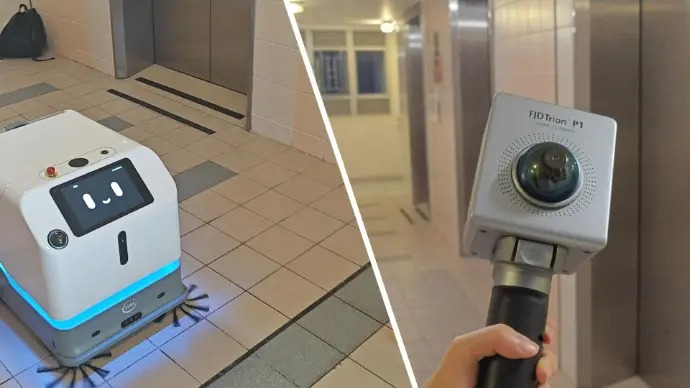"What used to take us weeks of tedious work with the cleaning robot mapping, the FJD Trion P1 helped us accomplish in just a few days. It's not just an improvement; it's a revolution in how we map our facilities."
From Slow and Tedious to Fast and Efficient:
How It Used to Be
Every smart cleaning robot needs an accurate map. However, creating such a map for high-rise buildings is a significant challenge.
Why? Because the traditional process is slow, labor-intensive, and prone to frustrations. Teams have to manually push a heavy robot to every single floor, often dealing with clumsy navigation issues like the robot getting stuck in elevator doors or bumping into walls. It is not just an inefficient method — it is utterly impractical.

In Hong Kong’s Southern District, a large public housing estate with 8 buildings, each 40 stories high, faced exactly this challenge.
When the decision was made to deploy smart cleaning robots across the estate, the goal was to reduce manual labor and increase cleaning efficiency. However, they quickly realized that without an accurate map of the facility, the robots couldn’t navigate the complex layout precisely. Creating these maps manually for such a high-rise environment proved to be a much bigger challenge than anticipated.
If the team had relied on the traditional mapping method, to map each of the 8 buildings, the team would need to manually push a cleaning robot to every floor, navigating each elevator, hallway, and obstacle. Given the size and complexity of the estate, this process could have taken weeks. The team would have faced numerous challenges in achieving the level of accuracy needed for the robots to function efficiently.
How 320 Floors Were Mapped in One Day
The key to this unprecedented efficiency was the FJD Trion P1 and a smart, replication-based workflow that leveraged the building's repetitive structure.

Rapid Data Capture
Instead of pushing robots around floor after floor, one technician with the FJD Trion P1 could walk through each building at a natural pace (~1.2 m/s), scanning every floor far quicker than the slow-moving robots (~0.5 m/s), avoiding the issues that plagued the old manual method.
Smart Strategy
By scanning just one representative floor per building, the FJD Trion P1’s data was replicated for all other identical floors. This dramatically reduced total scan time, allowing to map multiple floors in just one day.

Why FJD Trion P1 Made the Difference
- Portability & Ease of Use: The FJD Trion P1 weighs just 1 kg, making it incredibly portable. A single operator can carry it in a bag and start mapping the entire building anytime, without the need for additional crew members or complicated equipment setups.
- Fast Map Editing: Once the data was captured, it was quickly processed. With the FJD Trion P1, the team could edit the maps in bulk — drawing virtual walls, and fine-tuning the details for maximum accuracy. This saved hours of backend work, making the entire mapping process faster and more efficient.
- Seamless Integration with Cleaning Robots: After the maps were finalized, they were directly integrated into the cleaning robots’ systems, enabling them to navigate the entire estate with precision. The robots could now work autonomously, cleaning more efficiently, avoiding obstacles, and reducing downtime.

What once took weeks to accomplish now takes only a fraction of the time. With the FJD Trion P1, we've redefined facility mapping — swift, precise, and revolutionary. Ready to revolutionize your operations? Contuct us today and let the FJD Trion P1 accelerate your success today.
Stop pushing robots. Start walking with FJD Trion P1.